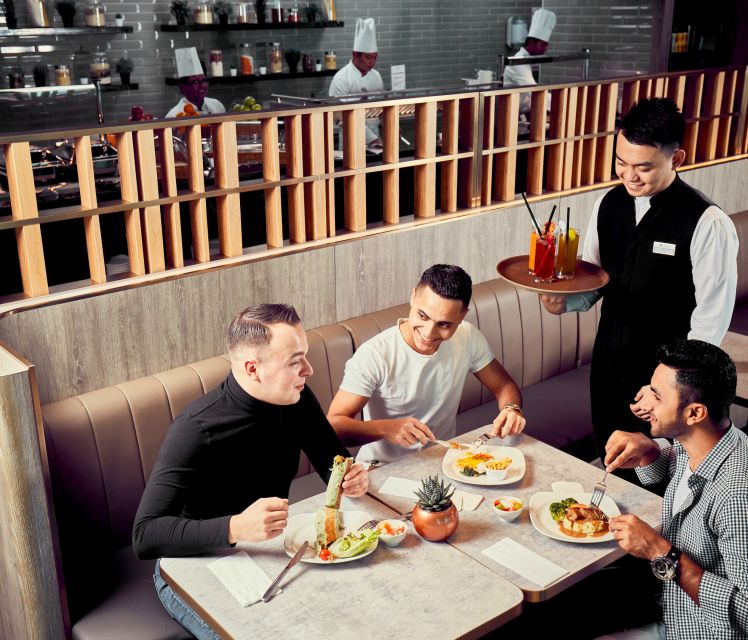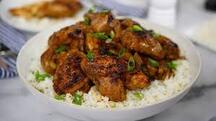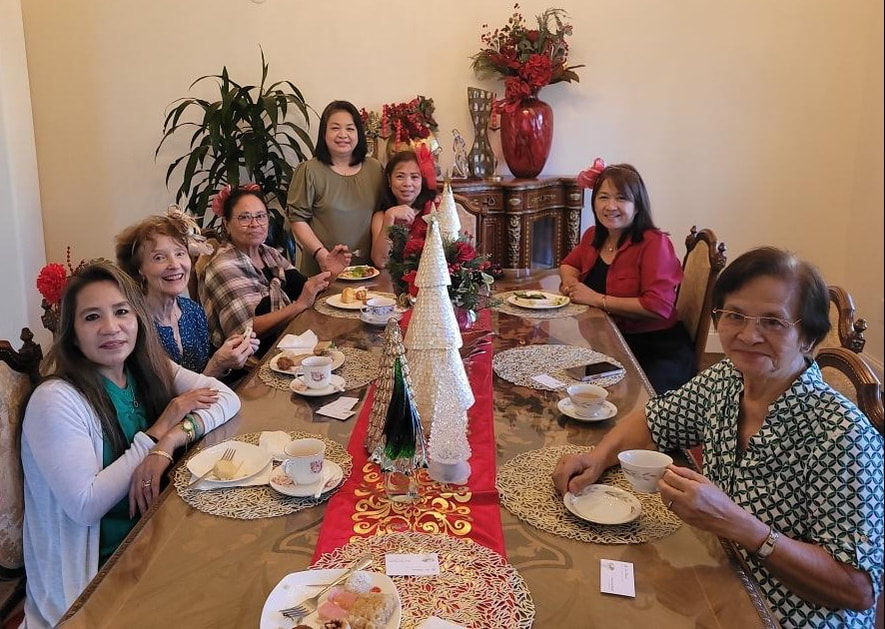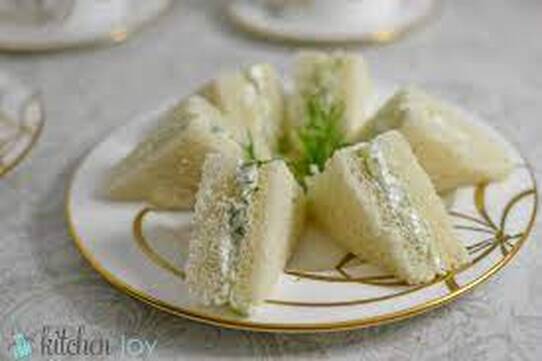Readers who wander through “The Tea Book” on this website, myteaplanner.com, will notice that our menus for tea parties offer a wide variety of food traditions and cultural perspectives. My co-author, Kathleen and I are both life-long learners and travel enthusiasts who are always eager to discover something new through the food we encounter along the way. The “World of Tea Parties” section of The Tea Book takes us around the globe with menus and recipes for A Chinese Dim Sum Tea, A Portuguese Tea, A Classic British Afternoon Tea, An Indian Chai Party, A California Tea, A Hawaiian Tea, An Italian Tea, A Southern American Tea, A Russian Tea, a French Afternoon Tea, and a Kosher Tea with Traditional Jewish Foods.
Among these international menus, you will find the recipes for sweet and savory foods that are famous favorites at tea parties far and wide. Here are a few: Egg Yolk Cream Tarts, Classic Cucumber Sandwiches, Chocolate Mousse, Tea Marbled Eggs, Sweet Lassi, Biscotti, Flan and Fried Green tomatoes. I think our Afternoon Tea savvy readers can guess from which international menu each of these delicious food items originated.
Here are the answers in chronological order, but watch out, I may have tricked you with one of the items:
Portugal, Britain, France, China, India, Italy, California, and the American South.
Did any of you say, “Wait a minute. Flan is from Spain”? You would be right, of course, but Flan is also a dessert staple in California, (which was once owned by Spain,) Mexico (which was also once owned by Spain,) Japan, where it is hugely popular and is still called “flan,” and The Philippines, also a former Spanish colony, where it is known as Leche Flan or milk flan. This reveals the universality of some of the world’s most popular Afternoon Tea menu items. Another example is Russian Tea Cakes, which not surprisingly, appear in our Russian Tea menu. The identical item, a luscious round butter cookie filled with ground toasted almonds and rolled in powdered sugar, is known in Mexico as Mexican Wedding Cookies and can be found on our website in six of our menus, as it is one of the most popular cookies in the world and welcome at any tea party.
While our World of Tea Parties chapter highlights the country where the tea plant was first grown (China,) the country that brought tea to Europe (Portugal,) the country that made Afternoon Tea world famous (Great Britain,) and many other countries and regions well known for their love of tea, it is certainly not a comprehensive survey of Afternoon Tea throughout the planet. For that reason, my co-author Kathleen suggested in 2016 that we each write a monthly blog to augment the content of our website and provide additional learning opportunities and culinary adventures for our readers.
Since then, my blogs have introduced you to the cuisine and or Afternoon Tea customs in Ethiopia, Rome, Venice, Milano, Cuba, Nova Scotia, South Africa, Botswana, Zambia, the countries along the Danube River, Australia, Lanai and Japan and have featured additional recipes from Russia, India, Ireland, Greece and Spain.
My August 2021 blog also included the recipe for Tibok Tibok, a delicious gluten-free chocolate pudding from the Philippines that contains almost exclusively chocolate, coconut milk and sugar.
I think it’s time to learn more about the food and culture of the Philippines.
There are 4.4 million Filipinos living in the United States. This number includes 1,814,000 Filipino Americans who were born in the Philippines. Filipinos comprise the second largest Asian immigrant population, with Chinese being the largest. The vast majority of Filipino Americans live in California, where I spent the majority of my adult life, or Hawaii, the state where I now live. I was in my early teens when my family moved to California and there were many Filipinos in our school and living in our neighborhood. However, there were very few Filipino restaurants to be found. While Chinese, Italian and Mexican restaurants were everywhere, Filipino food seemed to be available at that time only in Filipino homes.
I was lucky that the Pamanian family, immigrants from the Philippines, lived next door to us when I was in high school and the two older daughters, Nita and Virgie, invited me over to their house to eat all the time. Their mother would always be in the kitchen, and she had already started cooking dinner before we got home from school. I was astounded by the aromas that filled their home, the variety of ingredients, fresh fruits and vegetables, meats and fish, rice and noodles and herbs and flavorings that I had never encountered before. Every meal felt like a festival, and the warmth and generous welcome I experienced in the Pamanians’ home will stay with me forever. I will always love Filipino food because Filipino food is delicious, healthy and lots of fun.
Filipino food is complex and inclusive, colorful and abundant. Influences from neighboring countries, such as China, Indonesia and Japan, and from the countries that have affected Filipino history and culture, including Spain and The United States, are ever present. Filipino cuisine also has a traditional “over the top” quality, as though every day were Christmas. Many of the most famous Filipino dishes contain a large number of ingredients, including multiple spices and herbs and more than one kind of meat as well as various vegetables and seafood.
Here's a quick survey of a few of the basics of Filipino cuisine:
ADOBO, an indigenous Filipino method of flavoring meats and seafood using vinegar, soy sauce, fish sauce, garlic, peppercorns and bay leaves. In the Sixteenth Century, the Spanish applied the word “Adobo” to this cooking method, coincidentally used in Spanish and Portuguese cuisine.
LUMPIA, similar to Chinese spring rolls, lumpia are fillings wrapped in paper-thin pastry skins and served either fresh or fried for a crispy texture. Perfect for afternoon tea, this tasty finger food can be filled with either savory ingredients such as ground pork and vegetables or sweets such as bananas.
ENSAYMADAS are brioche-like sweet pastry rolls that originated in Mallorca in Spain and are now among the most popular holiday desserts in the Philippines. Ensaymadas are made with a rich dough containing butter and cheese and are often topped with additional buttercream icing and cheese. Ensaymadas would be an interesting substitute for Scones at any tea party.
HALO HALO is the Philippines’ most popular dessert, and it typifies the exuberant overabundance and complexity of Filipino cuisine. The perfect refresher for a hot climate, Halo Halo is served in a decorative sherbet dish with every tasty and icy morsel that anyone, especially a child, could imagine, adding plenty of color, mixing all the ingredients together and placing a bright paper umbrella on top. A typical serving of Halo Halo includes shaved ice with condensed milk poured on top, a huge purple scoop of Ube (Asian purple yam) ice cream, a large dollop of sweet potato jam, also purple, a generous cube of flan, precariously perched at the edge of the dish, strips of fresh coconut and jackfruit, and floating on the bottom, what seem like hundreds of cubes of multi-colored, usually red and green, gelatin mingling with sweetened red azuki beans.
And this astounding dessert is not reserved just for special occasions. Now that there are Filipino restaurants, especially in California and Hawaii, diners who enjoy a meal of chicken and or pork adobo, pancit, rice, fish filets in black bean sauce with slices of fresh ginger and perhaps a platter of sizzling tofu piled high with jalapenos and sliced red and green bell peppers, will typically conclude this little feast with a bowl of Halo Halo. I should point out that Filipino restaurants such as Max’s of Manila in Honolulu, serve the food family style, as though the diners are at home, eating a meal that their mothers cooked; thus, everyone gets to taste several different dishes. This sense of community and hospitality is ever present in Filipino restaurants, and it is rare to see an individual eating alone.
Recently, by a strange quirk of fate, I had the wonderful opportunity to experience a Filipino Afternoon Tea party in the home of my new friend Vivian Flora, a fabulous home cook who grows her own herbs, mixes her own seasonings and makes her own sauces. She also welcomes her guests with the sense of joyful abundance that still animates Filipino family life today. Vivian and I met only recently and discovered that we are both retired educators whose long teaching careers took place in San Jose California. Upon retirement, both of us moved to Oahu with our husbands without knowing anyone in Hawaii. As fate would have it, we and our husbands accepted an invitation from the President of San Jose State University, Cynthia Teniente-Matson, to attend an Alumni reception in Honolulu to allow San Jose State graduates living in Hawaii to meet and greet the President of the University and one another. As each of us was introducing ourself to the group, Vivian’s husband, Maurino, a gregarious entrepreneur and marathon runner, recognized me as his English Professor at Evergreen Valley College in San Jose, decades ago. In the friendly chat that followed, I learned that Maurino and Vivian knew each other in kindergarten in the Philippines and immigrated to the U.S. years later. I shared the fact that one of my current activities is writing blogs for my Afternoon Tea website, and Vivian invited me to the tea party that she hosts each year during the holiday season.
Vivian is very knowledgeable about international tea foods, customs and aesthetics, and she has the organizational skills and artistic vision to plan and host an Afternoon Tea gathering that will bring a sense of joyful belonging to each of her guests. The tea party I attended at her home in Honolulu was a complex event including more guests, more food and more activities than most tea parties while maintaining the foundational principles of harmony, humility, creativity and respect. Her international menu featured both savory and sweet foods, including the traditional English style small tea sandwiches with the crusts removed. Vivian prepared some of the food items herself, and others were brought by guests, and some purchased at local bakeries. Guests enjoyed selecting their favorites from this extensive menu:
FESTIVE FILIPINO TEA MENU
Vivian served three different teas from her personal collection, each in a decorative teapot with a burner to keep each pot at the perfect hot temperature:
Rooibos with Cinnamon and Rose Hip
Rose and Chamomile with Tropical Fruits
Herbal Lemongrass Ginger Tea
SAVORIES
Herbed Cucumber Tea Sandwiches on White Bread (made by Vivian)
Smoked Salmon Sandwiches with Dijon Mustard on Brown Bread (made by Vivian)
Chicken Salad Sandwiches
Egg Salad Sandwiches
Mini Crab Cakes
Lumpia
SALADS
Filipino Macapuno Fruit Salad
Spring Greens Salad with Dressing
Pasta Salad
BREADS
Cheese Ensaymadas
Ube Ensaymadas
Cinnamon Rolls
Puto (Filipino steamed rice cupcakes)
SWEETS
Leche Flan
Pink Mochi Bars
Fried Mochi Balls
Palmiers
Biko (Filipino sweet rice cake)
Mini Cheesecakes with Greek Cherry Sauce
Chocolate Chip Cookies
Spritz Wreaths, Mexican Wedding Cookies and Orange Ginger Cookies, (made by me)
Guests were encouraged and welcome to return to the elegant buffet-style serving area and to eat as much as they liked. At the end of this three-hour event, we were provided with containers to take home generous portions of food to share with our families. Vivian’s Afternoon Tea party, artistically decorated with a red, white and gold color theme, also included holiday-themed parlor games, crafts, quiet time for spiritual reflection, a joyful gift exchange among the guests and plenty of old-fashioned female bonding. It was delightful to spend the afternoon with this group of friendly, happy and interesting women, and when this lovely event ended, Vivian gifted each us with an aromatic woodsy scented candle to brighten our homes during the winter holidays. In addition, one of the guests, Johana, generously gave every attendee a decorative coffee or tea mug with a small packet of coconut flavored Hawaiian Paradise Coffee.
Vivian has agreed to share her recipe for Herbed Cucumber Tea Sandwiches, her own adaption of the traditional British version, using a spice mix that Vivian has developed herself.
Cucumber Sandwiches are the stars of every traditional Afternoon Tea, and the British version, with thin slices of cucumber, lightly salted and placed between two slices of buttered bread, are delicious. However, I liked Vivian’s Herbed Cucumber Sandwiches even more. Her Herb Blend adds an intriguing complexity of flavor and zip, and the combination of cream cheese and yogurt creates a refreshing partnership with the subtle flavor of just-sliced cucumbers.
Freshness is everything with Cucumber Sandwiches, so try to make yours as close to serving time as possible. If you are planning a Valentine’s Day Tea party this year, try surprising your guests with this innovative version of the old classic. And take another look at Vivian’s Festive Filipino Tea menu. I think Lumpia, Leche Flan and Ensaymadas would add a little extra romance and celebration to your Valentine’s Day Afternoon Tea.
- 1 loaf of soft bread, white or wheat
- 1 English cucumber, washed and thinly sliced diagonally
- Equal parts of cream cheese and Greek yogurt, (about ½ cup each)
- 1 tablespoon of fresh dill, washed and chopped
- 1 teaspoon of Vivian’s house-blend seasoning:
equal parts of ground onion, thyme, basil, oregano, cilantro, parsley, garlic, paprika, salt, pepper, and a pinch of cayenne pepper.
Makes: approximately 24 small triangular sandwiches
- Make Vivian’s Spice Blend: Vivian grows and dehydrates her own herbs, then grinds them for her own recipes. If this is more than you can manage, use store-bought pre-ground herbs and spices. To create a good supply of this spice blend for use in your own everyday cooking, I recommend using 1 teaspoon each for all the ingredients Vivian has listed, but with only about ¼ teaspoon of cayenne pepper. Keep this mixture in a glass container with a tightly fitting lid. Of course, you can use smaller amounts of each spice for this specific recipe if you wish.
- Wash and slice the cucumber and set aside in a small bowl. Place the cream cheese and Greek yogurt in a medium sized bowl and blend the mixture together with a fork until smooth. (Use a blender if you prefer.) Add 1 tablespoon of chopped fresh dill and 1 teaspoon of Vivian’s Spice Blend and mix again until well incorporated. Add more dill, spices or a pinch of cayenne to adjust the taste to your own liking.
- Lay the slices of bread on a cutting board, in rows of two next to each other. Spread the cream cheese, yogurt and herb blend on one slice of bread. Arrange the cucumber slices on top of the spread, creating a double stack of the cucumber slices. Top with the second slice of bread. Continue creating the sandwiches until you have used up the loaf of bread.
- Slice the crusts off each sandwich using a serrated knife. Quarter each sandwich by slicing it diagonally both ways into diamond shapes. Garnish and serve immediately or cover loosely with a damp kitchen towel to prevent drying out until ready to serve.



















 RSS Feed
RSS Feed